If you are looking for a tattoo that is rich in symbolism and celebrates life and death, then the “Day of the Dead” tattoo might be right for you. The Day of the Dead is a Mexican holiday that honors loved ones who have passed away. It is a time to celebrate their lives with colorful altars, food, flowers, and festivities. Over time, the Day of the Dead has become a popular theme for tattoos, both as a way to remember loved ones and to celebrate the cycle of life and death. In this article with Impeccable Nest, we will explore the meaning of Day of the Dead tattoos.
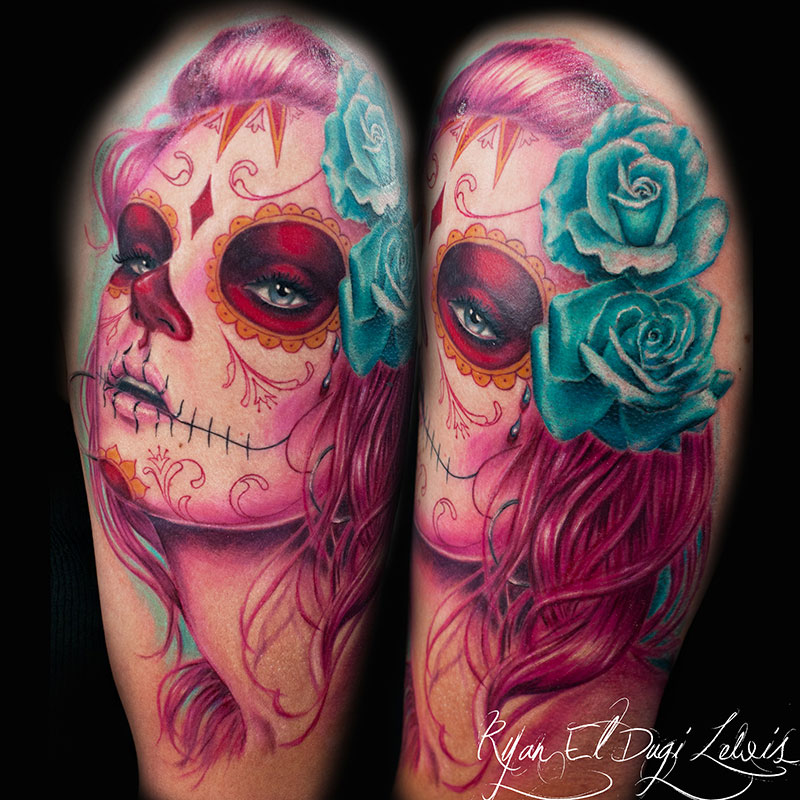
Day of the Dead Tattoo Meaning: Exploring the Cultural
Day of the Dead tattoos have a rich and deep meaning that goes beyond just remembering loved ones who have passed away. Here are some of the most common meanings associated with Day of the Dead tattoos:
Celebration of Life and Death
The Day of the Dead, or Dia de los Muertos, is a vibrant and meaningful celebration observed in Mexico and other Latin American countries. It is a unique blend of indigenous traditions and Catholicism, honoring deceased loved ones and embracing the natural cycle of life and death. Day of the Dead tattoos encapsulate the spirit of this celebration, serving as a visual representation of the profound meaning behind this cultural event.
One of the fundamental aspects of the Day of the Dead tattoo meaning is the celebration of life itself. This holiday encourages people to remember and honor their departed family members, friends, and ancestors. As such, Day of the Dead tattoos often incorporate elements that symbolize life’s vitality and joy. These tattoos feature colorful designs, lively imagery, and intricate details, reflecting the vibrant and festive atmosphere of the celebration.

Skulls, known as calacas or calaveras, are prominent symbols in Day of the Dead tattoos. Contrary to the common association of skulls with darkness and morbidity, the use of skulls in this context represents the cycle of life and death. Rather than being grim reminders of mortality, they serve as powerful reminders to live life to the fullest and appreciate every moment. These skulls are often adorned with flowers, which are symbols of beauty and growth, further emphasizing the celebration of life.
Day of the Dead tattoos frequently feature various other significant symbols that contribute to their rich meaning. Marigolds, for example, hold great importance during the celebrations as they are believed to attract the spirits of the departed back to the world of the living. Therefore, marigolds are often incorporated into these tattoos as symbols of remembrance and as a means to guide and welcome the souls of loved ones.
Another prevalent symbol found in Day of the Dead tattoos is the sugar skull or calavera de azúcar. These intricately designed skulls are typically created using bright colors and decorative patterns, adding a sense of whimsy and joy to the tattoo. Sugar skulls not only represent the departed individuals but also serve as a reminder of the sweetness and richness of life that should be celebrated.
Furthermore, Day of the Dead tattoos often incorporate other elements such as candles, crosses, and religious iconography, blending indigenous beliefs with Catholic traditions. These symbols represent the spiritual aspect of the celebration, signifying the belief that death is not an end but a continuation of the journey of the soul.
In conclusion, Day of the Dead tattoos hold deep cultural significance and convey a powerful message. They celebrate the essence of life, acknowledging the inevitable cycle of life and death with vibrant and joyful imagery. These tattoos serve as reminders to embrace life, recognize the beauty in fleeting moments, and honor the memory of loved ones who have passed away. By wearing a Day of the Dead tattoo, individuals express their connection to this rich tradition and their appreciation for the preciousness of life itself.
Remembrance of Loved Ones
Day of the Dead tattoos hold deep cultural significance and are gaining popularity around the world. Rooted in Mexican traditions, these tattoos showcase vibrant and intricate designs that symbolize the remembrance of loved ones who have passed away. Beyond their aesthetic appeal, Day of the Dead tattoos serve as a powerful and enduring memorial to someone special, allowing their memory to live on.
The Day of the Dead, or Día de los Muertos, is a vibrant and joyful holiday celebrated annually in Mexico and other Latin American countries. It is a time when families gather to honor and remember deceased loved ones. The holiday spans from October 31st to November 2nd, overlapping with Halloween and All Saints’ Day, and is marked by colorful decorations, lively parades, delicious food, and elaborate altars adorned with photographs, candles, marigold flowers, and the favorite belongings of the departed.
Day of the Dead tattoos capture the essence of this celebration, reflecting both joy and sorrow. The imagery commonly associated with these tattoos includes sugar skulls, marigold flowers, calacas (skeletons), candles, and other symbolic elements. These designs are often characterized by bold colors, intricate patterns, and a combination of beauty and macabre themes.
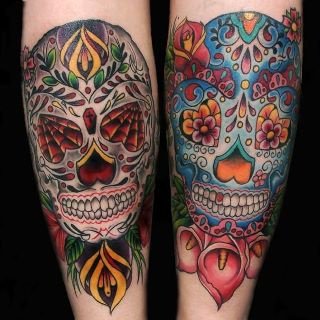
The central meaning behind Day of the Dead tattoos is the commemoration of loved ones who have passed away. By getting such a tattoo, individuals strive to create a permanent reminder of those they hold dear and to honor their memory. These tattoos can be deeply personal, serving as a tangible connection between the wearer and the departed.
In addition to being a tribute to the deceased, Day of the Dead tattoos also represent an acceptance of death as a natural part of life. They embrace the belief that the spirits of our loved ones continue to exist and can visit us during this special time of year. Day of the Dead tattoos convey a sense of celebration, emphasizing the idea that death should not be feared but rather celebrated, as it allows us to remember and honor those who have shaped our lives.
Moreover, Day of the Dead tattoos can function as a form of healing and coping with grief. For individuals who have experienced the loss of someone close, these tattoos offer a way to keep the memory of their loved one alive, providing comfort and solace in times of sadness or longing. They serve as a visual representation of the ongoing relationship between the living and the departed, reminding us that the bond with our loved ones transcends physical existence.
Each element within a Day of the Dead tattoo holds its own symbolism. Sugar skulls, for example, are often adorned with intricate designs and colorful patterns. These vibrant decorations represent the joyous remembrance of the departed and highlight the idea that life should be celebrated. Marigold flowers, known as cempasúchil or “flower of the dead,” are an essential part of Day of the Dead celebrations as they are believed to guide the spirits of the deceased back to their loved ones.
Candles, another common motif in these tattoos, symbolize light, guidance, and hope. They are used during the festivities to illuminate the path for the spirits, allowing them to find their way home. Calacas, or skeletons, are depicted in various poses and activities to portray that death is merely a transformation rather than an end. They represent the joyful and humorous side of death, encouraging people to embrace life to the fullest while they can.
In conclusion, Day of the Dead tattoos hold immense meaning as a permanent memorial to loved ones who have passed away. They embody the rich cultural traditions of Mexico and Latin America, serving as a visual representation of the celebration, remembrance, and acceptance of death. These tattoos not only keep the memory of the departed alive but also provide comfort and healing to those who wear them, acting as a constant reminder of the enduring bond between the living and the deceased.
Connection to Mexican Culture
Day of the Dead tattoos hold deep cultural significance and are rooted in the rich traditions and customs of Mexico. These tattoos serve as a meaningful way to pay homage to Mexican heritage and celebrate the Day of the Dead, or Dia de los Muertos, which is a vibrant and colorful holiday observed annually.
The Day of the Dead is a time when families gather to honor and remember their departed loved ones. It is believed that during this celebration, the spirits of the deceased return to the world of the living to be reunited with their families. Rather than mourning, the Day of the Dead is a joyous occasion filled with music, food, and festivities.
When it comes to getting a Day of the Dead tattoo, individuals often choose designs that symbolize various aspects of this unique holiday. Common imagery includes sugar skulls, marigold flowers (known as cempasuchil), candles, crosses, and the iconic La Calavera Catrina, a female skeleton adorned with elegant clothing and a fancy hat. These elements represent the blending of indigenous beliefs with Spanish Catholic influences, creating a beautiful fusion of cultures.
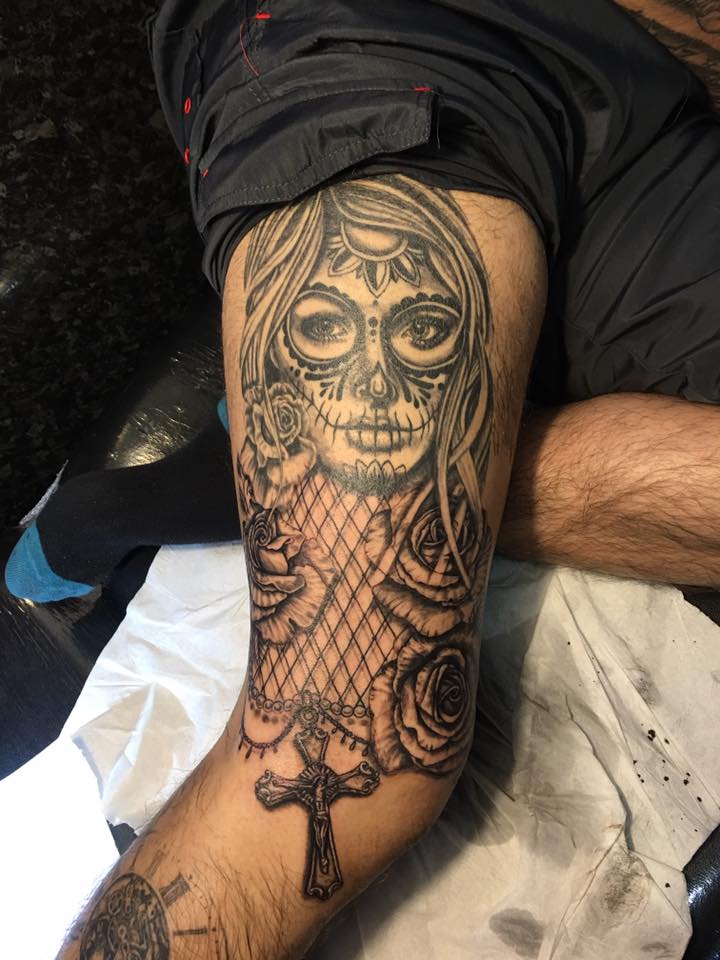
Sugar skulls are perhaps the most recognizable symbol associated with the Day of the Dead. These intricately decorated skulls are often depicted wearing bright, elaborate patterns and designs. They serve as a reminder that death is just another part of life and should be embraced rather than feared. Sugar skulls are also personalized with the names of deceased loved ones, transforming them into unique tributes.
Marigold flowers play a significant role in Day of the Dead celebrations as well. Their vibrant orange and yellow colors are believed to guide the spirits back to their families, acting as a pathway from the spirit world to the earthly realm. Marigolds are used to decorate altars, gravesites, and even incorporated into tattoos to symbolize the beauty and transitory nature of life.
Candles are an integral part of Day of the Dead ceremonies, as they help illuminate the way for the returning spirits. In tattoos, candles are often depicted alongside skulls and other symbols to represent illumination and guidance.
Crosses are another common motif found in Day of the Dead tattoos. They symbolize the intersection between life and death, as well as the spiritual connection between the living and the departed. The cross is a powerful symbol of faith and serves as a reminder of the Catholic influence on this traditional Mexican holiday.
La Calavera Catrina, an elegant female skeleton, is an iconic image associated with the Day of the Dead. This figure was created by Mexican artist José Guadalupe Posada and later popularized by muralist Diego Rivera. La Calavera Catrina represents the idea that death does not discriminate, and regardless of social status or wealth, everyone eventually meets the same fate. Including this image in a tattoo reflects a pride in Mexican art and culture while acknowledging the universality of death.
Day of the Dead tattoos hold immense symbolism and serve as a visual representation of one’s cultural identity. They express pride in Mexican heritage and honor the traditions and customs passed down through generations. These tattoos are more than just decorative body art; they encapsulate the spirit of the Day of the Dead and allow individuals to carry their cultural heritage proudly wherever they go.
Symbolism and Iconography
Day of the Dead tattoos hold a profound meaning and are deeply rooted in symbolism and iconography. They are inspired by the traditional Mexican holiday, Dia de los Muertos, which is celebrated to honor and remember loved ones who have passed away. These tattoos are not only visually striking but also carry significant messages about life, death, and the eternal cycle of existence.
One of the most prominent symbols in Day of the Dead tattoos is the sugar skull. These intricate skull designs are adorned with vibrant colors, floral patterns, and elaborate decorations. Sugar skulls symbolize the celebration of life rather than mourning death. They represent the idea that death is a natural part of life and should be embraced rather than feared. This image signifies the joyous remembrance of departed souls and serves as a reminder to cherish life’s fleeting moments.
Marigolds, known as “Cempasúchil” in Spanish, are another common element in Day of the Dead tattoos. These bright orange flowers are believed to attract the souls of the deceased to the altars and gravesites during the holiday. Marigolds symbolize beauty, fragility, and the ephemeral nature of human existence. They are used to create vibrant floral arrangements and pathways, guiding spirits back to the world of the living. In tattoos, marigolds often surround or accompany the sugar skulls, emphasizing the connection between life and death and the importance of honoring those who have passed.
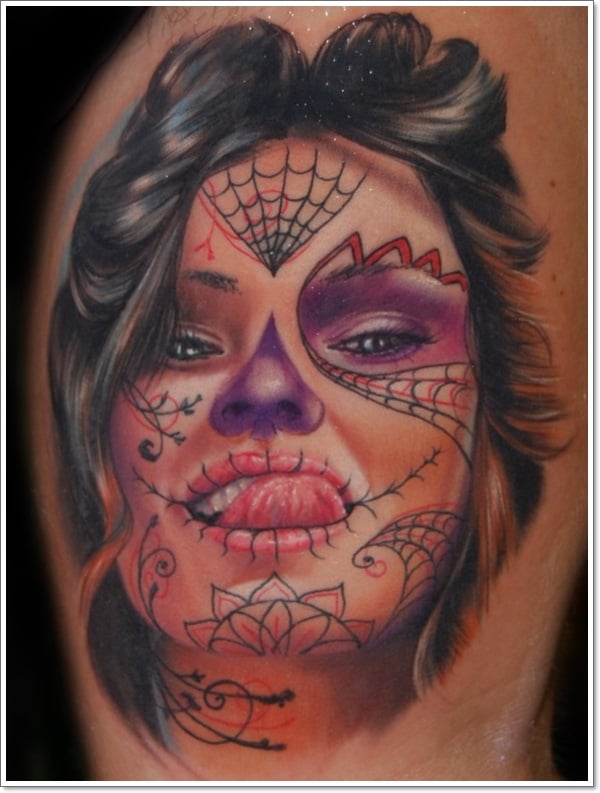
Monarch butterflies are frequently featured in Day of the Dead tattoos as well. These striking creatures are believed to embody the spirits of departed loved ones, carrying their souls on their delicate wings. Monarch butterflies symbolize transformation, rebirth, and the transcendence of the physical realm. They serve as a reminder that life is a continuous journey, and death is merely a transition to another state of being. Including monarch butterflies in Day of the Dead tattoos signifies the belief in the immortality of the soul and the interconnectedness of all living beings.
Other elements commonly found in Day of the Dead tattoos include candles, crosses, religious symbols, and the names or portraits of deceased loved ones. Candles represent light and guidance for the souls as they return to visit their families. Crosses and religious symbols signify faith and the spiritual aspect of the holiday. Adding the names or faces of departed individuals personalizes the tattoo, honoring specific loved ones and keeping their memory alive.
Overall, Day of the Dead tattoos are not just beautiful designs but also powerful expressions of cultural heritage and philosophical beliefs. They capture the essence of this vibrant Mexican tradition and convey profound messages about life’s transience, the embracing of death, and the celebration of those who have gone before us. These tattoos serve as a permanent tribute to our loved ones, reminding us to live each day to the fullest and cherish the precious moments shared with those who are no longer physically present.
Day of the Dead Tattoo Designs
Day of the Dead tattoos come in a wide variety of designs, each with their own unique meaning and symbolism. Here are some of the most popular Day of the Dead tattoo designs:
Sugar Skulls
Sugar skulls are one of the most iconic images associated with the Day of the Dead. These colorful skulls are decorated with intricate designs and represent the sweetness of life and the inevitability of death.
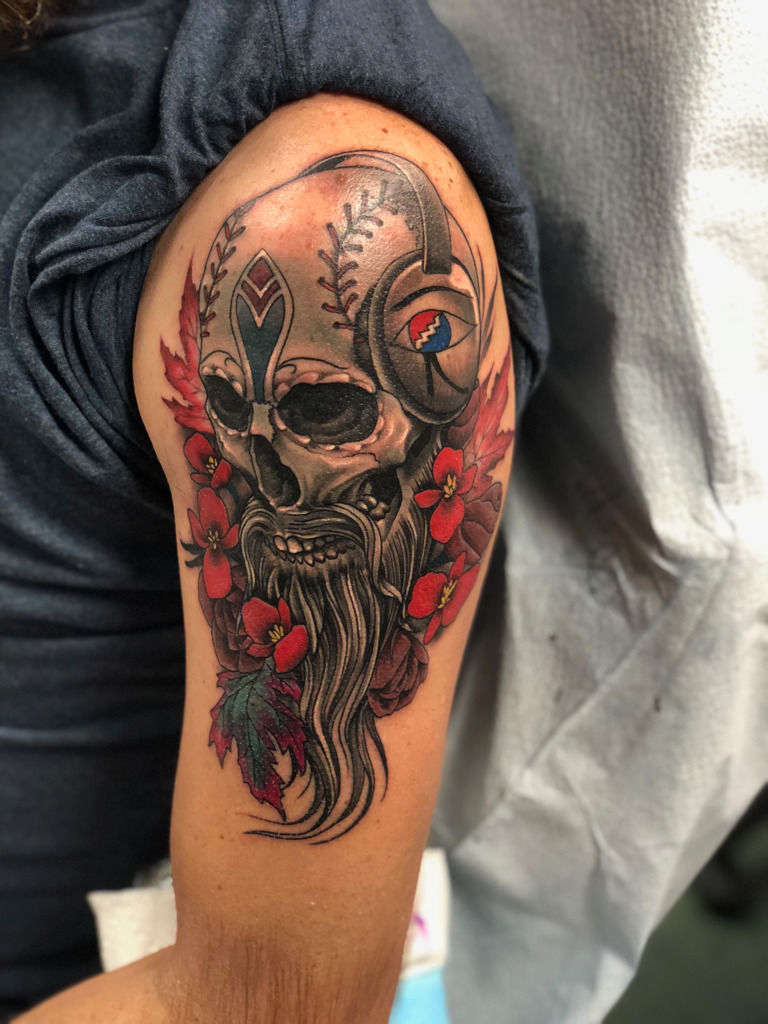
Calaveras
Calaveras are another common image in Day of the Dead tattoos. These are often depicted as skeletal figures dressed in festive clothing, representing the idea that death is not something to be feared but rather embraced as a part of life.
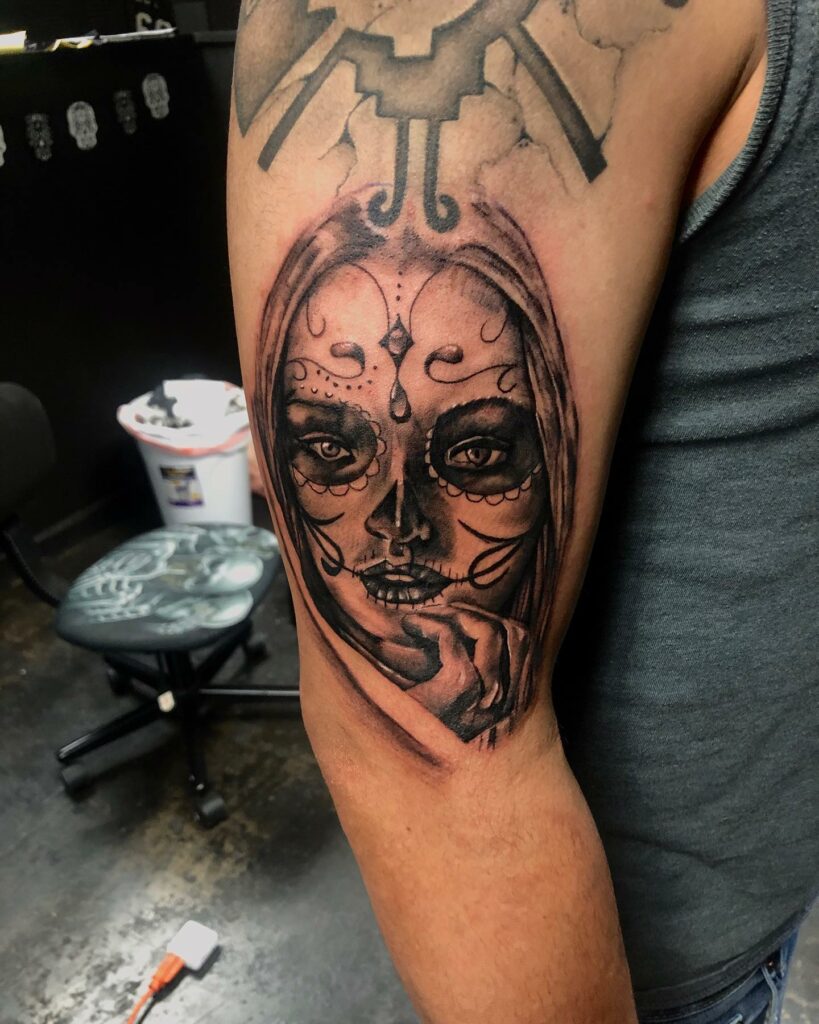
Flowers
Flowers, especially marigolds, are an important symbol in Day of the Dead celebrations. They are believed to guide the spirits of loved ones back to the land of the living and are often used to decorate altars and graves. In Day of the Dead tattoos, flowers can represent beauty, life, and death.

Monarch Butterflies
Monarch butterflies are another common image in Day of the Dead tattoos. These beautiful insects are believed to be the souls of loved ones returning to visit the living. They also represent transformation, change, and the fleeting nature of life.
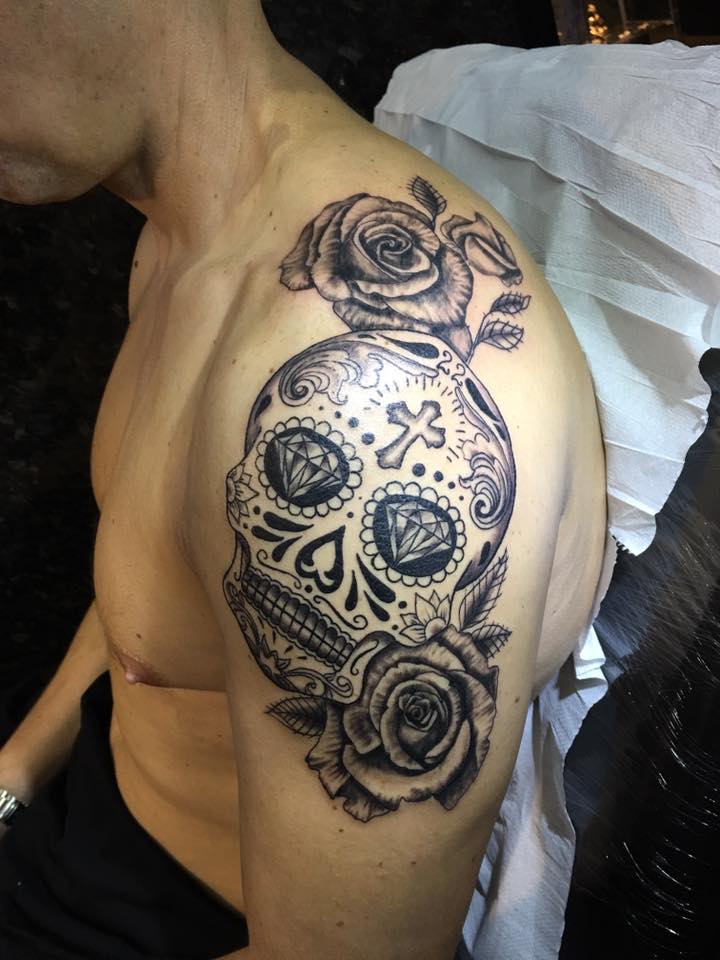
La Catrina
La Catrina is a popular figure in Mexican culture and is often depicted in Day of the Dead tattoos. She is a skeletal figure dressed in a large hat and elegant clothing, representing the idea that no matter how much wealth or status we attain in life, we are all equal in death.
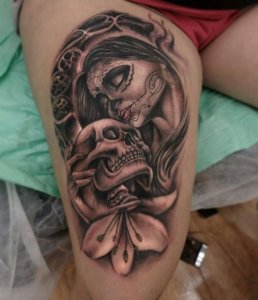
Comparisons of Day of the Dead Tattoos
While Day of the Dead tattoos share many common elements, each design is unique and personalized to the individual. Here are some comparisons of different Day of the Dead tattoo designs:
- Sugar skulls can be simple or complex, and can include a variety of colors and designs. Some people opt for a realistic sugar skull while others prefer a more stylized version.
- Calaveras can be depicted in a variety of poses, from dancing to playing music to simply standing still. They can also be dressed in different types of clothing, from traditional Mexican dress to modern-day clothing.
- Flowers can be incorporated into a Day of the Dead tattoo in many different ways, from a simple bouquet to an intricate floral design. Some people choose to include specific types of flowers that hold personal meaning or significance.
- La Catrina tattoos can vary in size and complexity, from a small ankle tattoo to a full back piece. They can also incorporate other elements, such as flowers or sugar skulls.
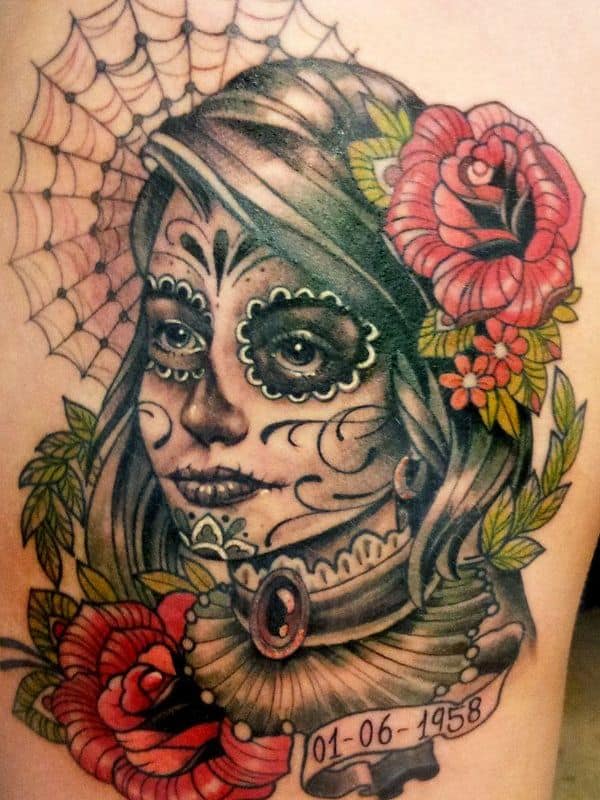
Conclusion
Day of the Dead tattoos beautifully capture the spirit of this commemorative holiday through symbolic motifs and vibrant designs. Skulls, marigolds, monarch butterflies, and La Catrina relate concepts of mortality, remembrance, rebirth, and honoring loved ones. By incorporating meaningful details, these pieces become poignant tributes to family and friends. Day of the Dead iconography translates exceptionally well into body art for its eye-catching colors and celebration of precious memories. The diverse range of styles and placement options allow for customize pieces tailored to memorialize lost loved ones.

I am Harvey Berry, a tattoo enthusiast who has immersed himself in the diverse world of ink, passionately exploring the beauty and artistry within each tattoo. My mission extends beyond uncovering the aesthetics of tattooing; it involves sharing in-depth knowledge across all aspects of this art form.
Fueled by genuine curiosity and love for every facet of tattooing, I have diligently crafted well-researched articles, with a special focus on the Tattoo Meaning of Impeccable Nest section. Here, my aim is to help the tattoo community gain a deeper understanding of the meanings and values embedded in each tattoo.
One of my primary goals is to encourage responsible decision-making when it comes to getting inked. I recognize that choosing to get a tattoo is a significant personal decision that requires careful consideration. Hence, I provide diverse resources covering the meaning of tattoos, the tattooing process, aftercare tips, and other valuable information.
Whether you are a seasoned tattoo enthusiast or embarking on your first exploration of the world of body art, I aspire to be a reliable resource for you at every step of your journey. I hope that my extensive knowledge of tattoos, especially in the Tattoo Meaning section, will assist you in finding inspiration to express yourself through the art of tattoos.
